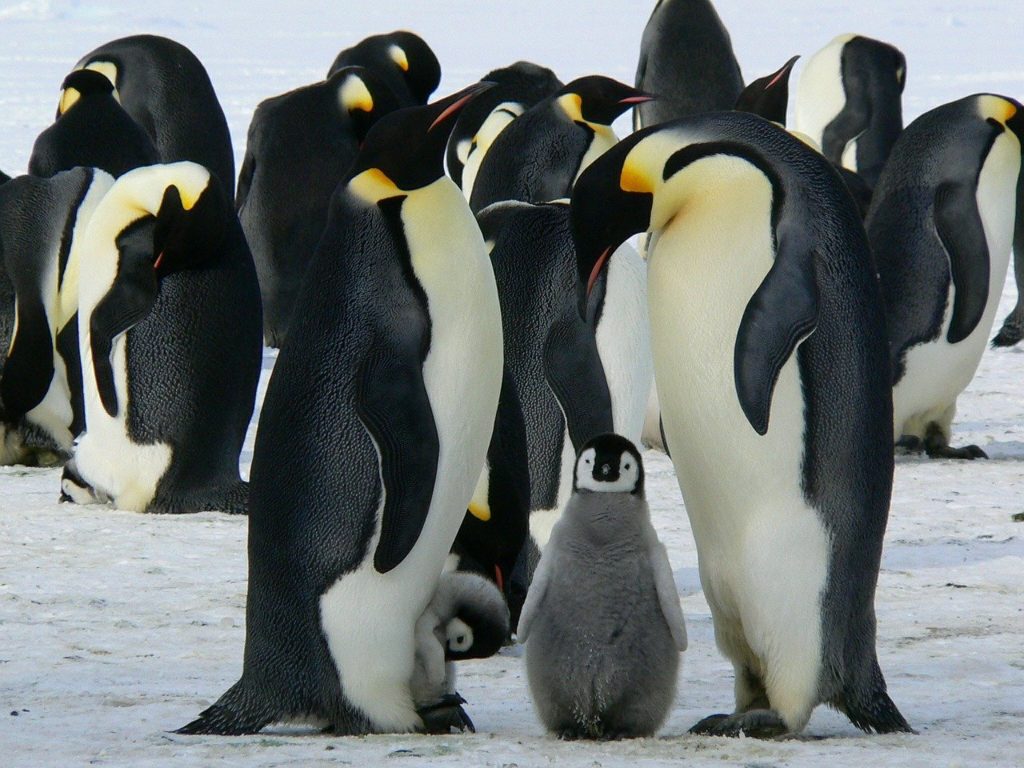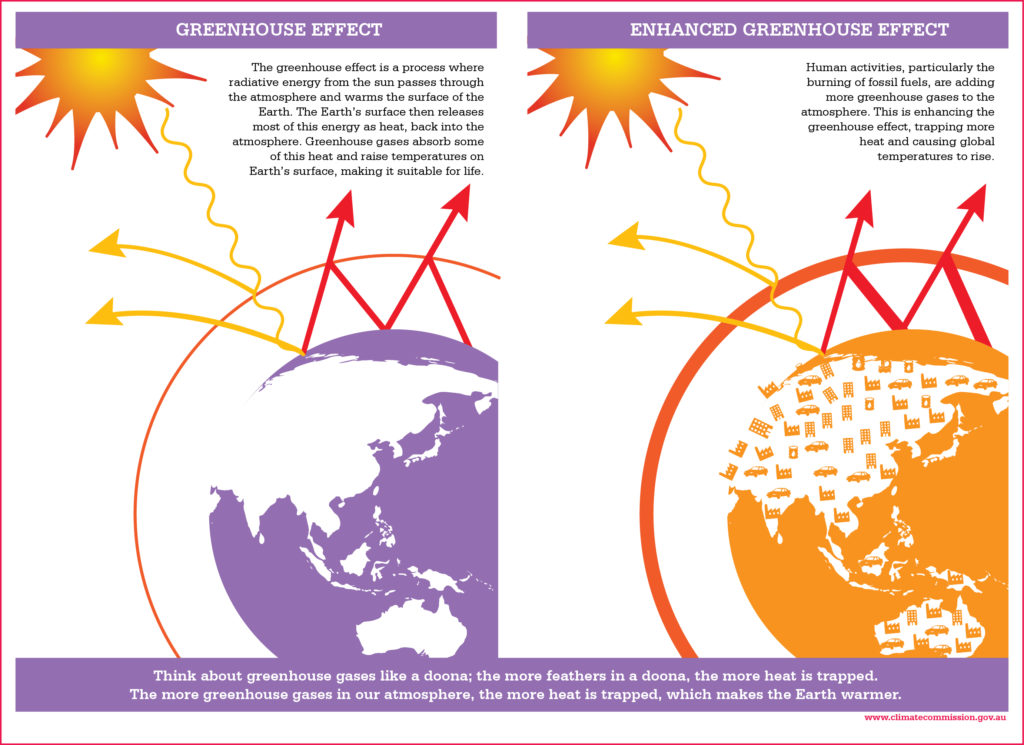Mount Stuart School Grade 3 Major

Our Questions
There have already been some major problems caused by the changes in our climate. One big problem is that the Earth is getting warmer, and this is causing things like land and marine heatwaves (yes, we have heatwaves in the ocean too!), and more powerful storms and cyclones. Cyclones get some of their energy from the heat in the ocean, and a warmer ocean provides more heat, and so a stronger cyclone results. That is bad news for people living on coasts when cyclones hit.
The changes in our climate are having significant impacts on animals and their habitats – in both the land and the sea. One of these major changes is loss of habitat. As the Earth gets warmer, some areas where animals live are changing or disappearing. For example, penguins that need ice to breed are losing their sea ice habitat in the Antarctic which means many of the chicks can die, as happened in 2023 for Emperor Penguins. As the habitat changes, some species move to new areas. Fish that need warmer water, and used to live off New South Wales are now found in Tasmania. You can see a list of these species at the RedMap Australia website: https://www.redmap.org.au/region/tas/.
Climate change can affect the availability of food for animals. Changes in temperature can disrupt the timing of when plants bloom or when animals give birth, which can lead to food shortages for some species. This can result in animals struggling to find enough food to survive.
All these challenges can lead to a higher risk of extinction for some species. When animals can't adapt to the changing conditions or find new places to live, their populations may decline and, in some cases, they may go extinct.
In Tasmania, and many other places, scientists are working hard to understand and address these challenges by implementing conservation strategies, such as creating protected areas for wildlife. Additionally, you and your family can help by taking actions to reduce your carbon footprint and protect natural habitats.
Like making dinner, bushfires require some key ingredients. These are: (1) fuel, (2) fuel dryness, (3) ignitions and (4) fire weather.
Fuel means plants that can be burned. This includes grasses and shrubs, leaf litter and twigs, tree trunks, and really any other plant material.
For fires to occur, the fuel must be dry enough to catch on fire. If the plant material is still growing and therefore has water inside of it, it is more difficult for it to catch on fire. Likewise, if the fuel is moist because it has recently rained, then it is unlikely to catch on fire. This is one of the reasons bushfires are more common during summer, when it is warmer and dryer.
For a fire to occur, there also needs to be an ignition source. Ignitions are often accidentally caused by humans. For example, there have been ignitions caused by a people driving over a dry paddock and their hot exhaust pipe ignited long dry grass. There have also been examples when people failed to put out their camp fire. These human-caused ignitions are something that we humans have control over, and thankfully we seem to be getting better at managing them. There are also natural sources of ignitions, like dry lighting, which is lightning that occurs when it is not raining. Dry lightning unfortunately seems to be getting more common.
The final key ingredient of a bushfire is fire weather. Fire weather describes the type of weather that would cause a bushfire to start spreading. Bad fire weather consists of hot, dry, and windy weather occurring at the same time. When it is hot and windy, the fire can quickly go from a small fire to a raging bushfire. These are the days when fire bans are in full effect, which is why it’s so important for us to make sure we don’t provide any new ignitions on days when fires can spread easily.
A carbon footprint is the total amount of greenhouse gases (the cause of climate change) that are generated by what we do. The carbon footprint will differ among individuals depending on their location, behaviour, and personal choices. Differences in carbon footprint between two people could come from, for example:
- The way they travel - there are no emissions when riding a bike, but a bus will have some associated emissions.
- Their location – a person using electricity in Tasmania (mostly from hydroelectric plants) will have lower emissions than someone living in Victoria (where much of the electricity is produced from coal).
- Their diet - vegetables have lower embodied emissions (emissions from production) than meat, although vegetables brought from overseas would have more emissions associated with their transport than meat produced locally.
When calculating a carbon footprint, it is important to include both direct and indirect emissions. For example, driving a non-electric car produces direct emissions from the use of fuel by the car, while using a computer produces indirect emissions from the use of electricity generated at a power station that uses fossil fuel. Similarly, a piece of paper or an apple (or anything we buy/consume) will likely have associated indirect emissions from the production and transport of the product.
Calculating your carbon footprint can be challenging but there are several online calculators that may help you to calculate emissions from various sources. Some examples are the Carbon Footprint Calculator For Individuals And Households or the ClimateHero Carbon Calculator.
Climate change can affect populations of animals in lots of ways.
Breeding – it can affect the way they breed every year. For example, Emperor penguins breed on the sea ice, in areas that are stable and don’t change from year to year. They lay their eggs on the ice and hatch the chicks and look after them until they are old enough to swim. But the areas of ice they breed on are being affected by climate change. Some areas of ice have shrunk, or broken up, destroying colonies that have bred in those areas for thousands of years. Some colonies are losing their special breeding areas and the number of chicks making it to adulthood is shrinking every year. Some breeding colonies no longer exist, because the sea ice they once used to raise their chicks is now gone. Over time this will slowly reduce the total number of Emperor penguins as there will be less new chicks coming into the population every year. Some colonies are ok and are not affected yet, but may be at risk in future.

Competition – Some populations of animals may be affected by competition for space or food as climate change affects their habitats. Populations of animals that live on the sea floor in the dark areas under sea ice, where there is not enough light for seaweed to grow, may have to compete with seaweed for space as the amount of sea ice changes. With less sea ice there is more light that reaches the sea floor, which is good for seaweed but bad for the animals that live in these areas. Seaweed can grow very quickly once it is established, crowding out animals such as sponges and corals – outcompeting them for space. This could result in a loss of biodiversity in these areas as lots of animals populations are replaced by seaweed.
Ocean acidification – This is the process that occurs as more carbon dioxide is absorbed by seawater. It makes it slightly more acidic each year which can affect animals in lots of ways. One way is by affecting those animals which make shells out of calcium carbonate. Ocean acidification makes it harder for them to make their shell, and eventually it could mean their shells start to dissolve. This is already happening to a planktonic animal called a sea-butterfly, or pteropods. These beautiful little animals have very thin fragile shells. Climate change through ocean acidification is causing their shells to be smaller and weaker. This might mean they have to put more time and energy into making their shells, which could mean less energy for reproduction. It could eventually cause them to die before they can reproduce, meaning that their populations will shrink. This could have serious effects on the food web in Antarctic seas, as pteropods are important food for lots of other animals like fish, penguins and even whales.
The how and the why of climate change are very tightly linked, so tightly linked people as far back as 1896 had figured out the basics of how it works. Earth’s atmosphere keeps the world warm by trapping heat. It does this in a way similar to the way a greenhouse works (thus the name “greenhouse effect”). Sunlight (and warmth) can come through the atmosphere in the day time and warms up the land and sea areas. At night cooling occurs, with the heat escaping into the atmosphere, some of that leaks out into space again, but not all because the atmosphere traps some of the heat. The key bit of the atmosphere that traps the heat are the greenhouse gases.

Natural greenhouse gases are water vapor, carbon dioxide, methane, ozone and nitrous oxide. These chemicals are an important part of the world’s natural cycles. They cycle between the atmosphere, the ocean, soils and rocks. Human activities have changed those cycles, meaning more greenhouse gases have entered the atmosphere, trapping more heat and leading to global warming and climate change.
Many human activities influence climate relevant cycles, but two of the most important are to do with carbon dioxide and methane. Fossil fuels contain carbon dioxide locked up millions of years ago, by bringing it to the surface and burning the fossil fuels human activity short circuits natural weathering and other cycles, creating one of the major sources of the excess carbon dioxide that is creating climate change.
Agriculture is also a major contributor to climate change, producing about a quarter of all current greenhouse gas emissions. These emissions come from the fuels used by farmers, but also because of emissions from rice paddies and livestock, which produce methane. A particularly powerful greenhouse gas, over a 20-year period methane is 80 times more potent at warming than carbon dioxide. On top of this, the removal of native vegetation, like forests, to create space for agriculture reduces the amount of carbon drawn out of the atmosphere and stored in trunks and roots as trees grow (known as sequestration).
As you can see there are many interconnected ways that human activities are influencing the biogeochemical cycles of Earth and thereby contributing to climate change.
Good sources of climate information are https://climate.nasa.gov/ and the new IPCC climate atlas https://interactive-atlas.ipcc.ch/
Two good Australian information sources are the CSIRO https://www.csiro.au/en/research/environmental-impacts/climate-change/Climate-change-QA and the Academy of Science https://www.science.org.au/education/immunisation-climate-change-genetic-modification/science-climate-change
You might also like to play with the simple climate model at en-Roads, explore options for reducing climate change https://en-roads.climateinteractive.org/scenario.html?v=21.10.0













